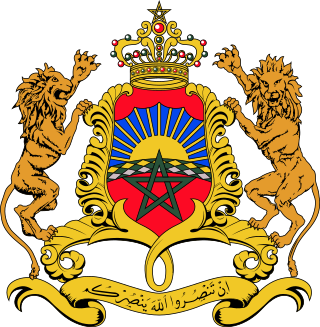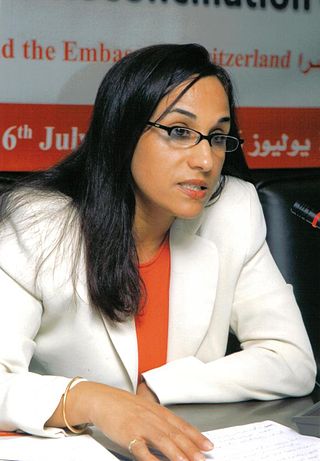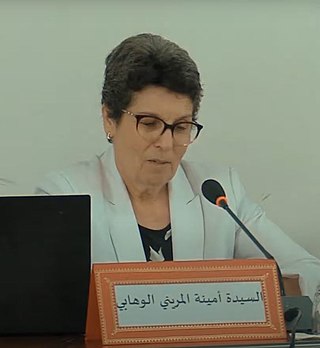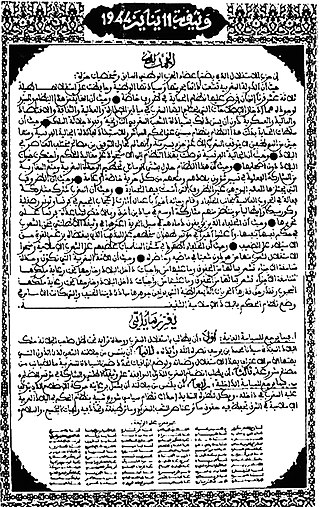
Essaouira, known until the 1960s as Mogador, is a port city in the western Moroccan region of Marakesh-Safi, on the Atlantic coast. It has 77,966 inhabitants as of 2014.

Princess Lalla Meryem is the first daughter and eldest child of the late King Hassan II of Morocco and his wife, Princess Lalla Latifa.

Mohamed Abdelaziz was the 3rd Secretary General of the Polisario Front, from 1976, and the 1st President of the Sahrawi Arab Democratic Republic from 1982, until his death in 2016.
Sidi Mohammed ben Abdallahal-Khatib, known as Mohammed III, born in 1710 in Fes and died on 9 April 1790 in Meknes, was the Sultan of Morocco from 1757 to 1790 as a member of the 'Alawi dynasty. He was the governor of Marrakesh around 1750. He was also briefly sultan in 1748. He rebuilt many cities after the earthquake of 1755, including Mogador, Casablanca, and Rabat, and Abdallah Laroui described him as "the architect of modern Morocco." He also defeated the French in the Larache expedition in 1765 and expelled the Portuguese from Mazagan (al-Jadīda) in 1769. He is notable for having been the leader of one of the first nations to recognize American independence in his alliance with Luis de Unzaga 'le Conciliateur' through correspondence and Unzaga's secret intelligence service and led by his brothers-in-law Antonio and Matías de Gálvez from the Canary Islands. He was the son of Mawlay Abdallah bin Ismail and his wife a lady of the Chéraga guich tribe.

The Royal Advisory Council for Saharan Affairs is an advisory committee to the Moroccan government on Western Sahara. It was created under Mohammed VI in early 2006, after a new autonomy plan proposed by Morocco to replace the United Nations' Baker Plan. The Polisario Front opposes Morocco's autonomy plan, demanding for a referendum and independence.

Gharb-Chrarda-Béni Hssen was formerly one of the sixteen regions of Morocco from 1997 to 2015. It was situated in north-western Morocco, covers an area of 8,805 square kilometres (3,400 sq mi) and has a population of 1,904,112. The capital was Kenitra.
Rita El Khayat also known as "Ghita". Ghita El Khayat,, is Moroccan psychiatrist, anthro-psychoanalyst, writer, and anthropologist. She studied at modern schools of Rabat and completed her graduation in the field of Psychiatry, Psychoanalyst and Medical Aerospace from Paris whereas graduation in Ergonomics and Occupational Medicine were completed from Bordeaux. She did her PhD in Anthropology of Arab World from.

Princess Lalla Aicha of Morocco was the younger sister of the late King Hassan II of Morocco, and daughter of King Mohammed V of Morocco and his second wife, Lalla Abla bint Tahar.

Fatima Sadiqi is a senior professor of Linguistics and Gender Studies at Sidi Mohamed Ben Abdellah University, in Fez, Morocco.

Latifa Akherbach is a Moroccan politician and journalist. Between 2007 and 2012, she was Secretary of State for Foreign Affairs in the cabinet of Abbas El Fassi.
Irreligion in Morocco is relatively uncommon, in the country. While a 2015 poll of about 1000 Moroccans by Gallup International found that 4% of respondents said they were "not religious", and 1% reported being a "convinced atheist", while 93% said they were religious
Mamfakinch, which means "no concession" or "not giving in", is a Moroccan citizen media website co-founded by Hisham Almiraat and Elmahdi El Mhamdi, among others. Mamfakinch known members include journalists Omar Radi and Nizar Bennamate as well as activists Zineb Belmkaddem and Soumia El Marbouh and several other anonymous members.

Sidi Slimane Province is a province of Morocco in the Rabat-Salé-Kénitra economic region. It covers an area of 1,492 square kilometres (576.1 sq mi) and its population in the 2004 census was 292,877. The province was created in 2009 by Decree # 2-09-319, out of the southwestern part of Kénitra Province. The province has two major urban areas: Sidi Slimane and Sidi Yahya. Sidi Slimane is the administrative headquarters.

Amina Bouayach is a Moroccan human rights activist. Since December 2018, Bouayach has served as the president of the Moroccan National Human Rights Council. In this role, she affirmed in 2019 that there are no "political prisoners in Morocco."

Amina Lemrini El Ouahabi is a Moroccan human rights activist, and the president of Morocco's Haute Autorité de la communication audiovisuelle.

Zainab Fasiki is a Moroccan graphic artist, activist for women's rights and mechanical engineer by training. She became internationally known after 2019, following her graphic novel Hshouma, corps et sexualité au Maroc which was translated from French into Moroccan Arabic, Spanish, Galician and Italian.

Miriem Bensalah-Chaqroun is a Moroccan businesswoman. She is CEO and vice-chair of Oulmes Mineral Water of Groupe Holmarcom. She is the president of Confédération générale des entreprises du Maroc from 2012 to 2018. She received the Wissam Al-Moukafa Al-Watania in 2013, the Order of Civil Merit in 2017 and the Legion of Honour in 2020.

The Proclamation of Independence of Morocco, also translated as the Manifesto of Independence of Morocco or Proclamation of January 11, 1944, is a document in which Moroccan nationalists called for the independence of Morocco in its national entirety under Muhammad V Bin Yusuf, as well as the installment of a democratic, constitutional government to guarantee the rights of all segments of society. January 11 is an official government holiday in Morocco.

Asmaa Rhlalou is a Moroccan journalist and politician of the National Rally of Independents (RNI). She has been a member of the Moroccan Parliament and was elected as the mayor of the Moroccan capital Rabat by the municipal council in September 2021.

Sidi Hamdi Ould Errachid is a Moroccan Sahrawi politician who is currently serving as the president of the Laâyoune-Sakia El Hamra regional council since 2015 under the banner of the Istiqlal Party.















